|
Snow Kidding?
Hunt for Light Geese in Illinois!
Tundra alert: goose hunters wanted.
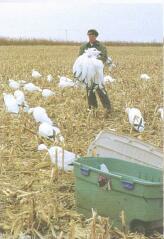
Tim Edison sets up a bundle of Texas rag decoys. Spreads of 500 to
1,000 decoys may be necessary to attract the attention of snow geese.
(Photos by P.J. Perea.)
|
STORY BY P.J. PEREA
Here they come!" Tim Edison whispered excitedly as
a large swarm of snow
geese, blue geese, Ross' Geese,
white-fronted geese and Canada
geese erupted off the steamy waters
of the nearby lake. It was late winter, and the light goose conservation season had just opened.
Edison, a waterfowling fanatic
from Loda, had several years of
the conservation season experience under his belt. Part of his
education in snow goose hunting
included a trip to hunt for light
geese at their wintering grounds in
Texas and Louisiana and then following them back to Illinois as
they migrated north.
The two battery-operated
callers were activated, and the air
filled with the electronic din of
cackling and squawking snow
geese grubbing on winter wheat
and corn. The deception was completed with more than 400 Texas
rag snow goose decoys (see side-bar), three dozen silhouette snow
and Canada goose decoys and a
few individual mouth calls from
camouflaged hunters hidden in the
field blind. Guns were checked
and steel loads were on hand for
fast reloading. It seemed strange
cramming six shells into the automatic feeder, but the special conservation season made allowances
for unplugged guns.
First-time goose hunter Brian
Kieninger of Pawnee quietly
inquired, "When should we shoot?"
as a group of two dozen birds slow-
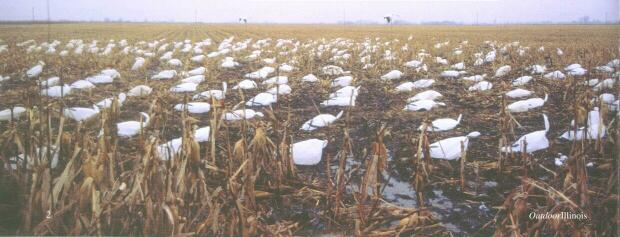
First-time snow goose hunter
Brian Kieninger was very pleased
to bag three snow geese. (Photo
by P.J. Perea.)
ly spiraled closer and closer to the
decoys. Overhead, thousands of
birds dotted the sky searching for
an open field to swarm upon, like
some strange group of hungry,
honking locusts.
"Let the first few birds land,
then the rest will just drop down,"
said Edison, "but watch for the
specklebellies and Canada geese—they're off limits."
It was a maddening 10 minutes
of watching and waiting, until one
very brave snow goose fluttered
into the landing zone and nestled
into the decoy spread. Then, all at
once, the rest of the flock dumped
altitude, dropped their feet and
lowered themselves into the 40-yard hot zone.
"Go! Go! Go!" were the last
recognizable words heard before
the noise of the electronic callers
was drowned out by the multiple
booms of shotguns emptying their
steel payloads into the foggy morning air. Three snow geese, two blue
geese and a bonus Ross' goose
crumpled under the curtain of steel
pellets. The rest of the flock safely
back-pedaled out of gun range and
joined the other geese heading out
for safer fields.
After the congratulatory high-fives, the geese were retrieved from
the fields, guns were reloaded and
the electronic calls were switched
off as a short reprieve for the
hunters' ears.
Listening to the monotonous
tone of snow goose calling will
slowly erode one's sanity, but then
again, some already question
waterfowl hunters' sanity. Who
else will get out of a toasty, warm
bed at four o'clock in the morning
to drill holes in a frozen cornfield
to accommodate the stakes of several hundred decoys?
Unlike Edison, relatively few
waterfowl hunters take advantage
of the tens of thousands of snow
geese, blue geese and Ross' geese
that occasionally make a pit stop in
central, western and southern Illinois. In fact, according to a report
from the Illinois Natural History
Survey Human Dimensions Program that examined the 2000-2001
light goose conservation season,
approximately 4,665 hunters harvested an estimated 36,800 geese.
Most of these migrating flocks
pass over the central flyway west
of the Mississippi River, but more
than a few make an appearance in
Illinois. Flocks follow the longer
days and warmer weather as winter
slowly gives up its grip to spring.
Depending on the weather, the
geese may stay a few days or several weeks, feasting on thawing fields
filled with waste grain from fall's
harvest. But the opportunity to
shoot into a sky filled from horizon
to horizon with geese is almost
reminiscent of the golden age of
waterfowl hunting and certainly is
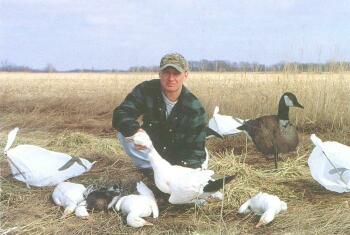
By using silhouette decoys to add
realism to the Texas rag spread,
Tim Edison was able to harvest
four nice snow geese and a blue
goose. (Photo by P.J. Perea.)
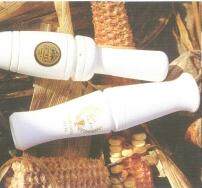
(Photo by Adele Hodde.)
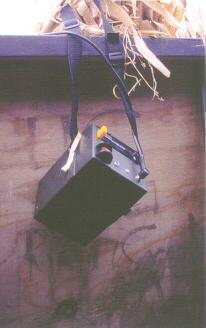
(Photo by P.J. Perea.)
|
enough of an incentive for die-hard
waterfowlers.
Besides, the hunters are doing
the Arctic tundra a big favor. The
light geese have devastated that
region's habitat. The warm winters
of the 1990s, light hunting pressure
and plentiful food supply of waste grain along the migration route
allowed the goose populations surrounding Hudson Bay to zenith into
abnormally high numbers. By some
estimates, the current population is
two times what it should be.
Light geese have a habit of grubbing (digging up the ground to find
tubers and plant roots)—a practice
that has wrought havoc on the
fragile tundra. The loss of vegetation has allowed soil to heat up,
releasing salt normally trapped in
the permafrost. The salt dissolves
in the groundwater, and the saline
fluid seeps up and contaminates the
surface soil. This renders the soil
inhospitable for plants. The damage
is widespread enough to detect with
infrared cameras mounted on orbiting satellites. Many areas of the
tundra may take decades to recover.
In response to the crisis, the U.S.
Fish and Wildlife Service enacted
the light-goose conservation season
that enlisted the help of millions of
waterfowl hunters to reduce the
burgeoning population of light
geese as they migrated across the
United States.
DNR State Waterfowl Biologist
Ray Marshalla commented, "It
appears the CO (conservation
order) seasons are successful."
Marshalla's report of the 1999-2000 harvest along the Central and
Mississippi Flyway stated: "The
harvest of Central and Mississippi
Flyway light geese during 1999/2000 was 1,488,633 birds. This
Use mouth calls (top photo) to call
in small groups or individual birds.
Use the electronic caller (bottom
photo) when there are too many
birds to count.
|
|
Hunting for a snow storm?
Hunting for light geese is challenging. They are very wary and unpredictable birds.
After several years of hunting light geese during the conservation season, here are a
few things I've gleaned from the field:
•Scouting is important when hunting for snow geese. Locate the field they are landing in
during the late afternoon and evening. It's likely they will return to that spot the next
morning.
•If two large groups are found in the field, try to set up between them. Groups tend to
exchange places throughout the day.
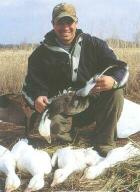
(Photo by Brian Kieninger.)
|
•Monitor the migration of light geese by checking frequently on internet waterfowl bulletin boards and sites like waterfowler.com and prairiestateflyway.com.
•Use an electronic caller with an adjustable volume control. Turn the call volume up to
get the flock's attention, and gradually turn down the caller's volume as they approach.
Geese have learned to become wary of unnaturally loud flocks of decoys.
•Use multiple electronic callers and several different tapes or CDs of feeding, flocking
and resting birds to give your spread a variety of noises.
•Use mouth calls to attract single or small flocks of geese. Sometimes too much calling
spooks the smaller groups, and individual birds can be convinced to land by talking to
them directly with a standard snow goose call.
•Large decoy spreads will attract the attention of birds. But the economic limitations of
expensive, full-body decoys makes Texas rag
decoys a great alternative. They are lightweight,
inexpensive, easy to set-up and maintain, and
they come in a variety of species.
•Along with large numbers of billowing wind-sock rag decoys, a touch of realism will convince birds that it's the real deal. Use
photographic silhouette decoys interspersed in
the flocks. (See www.outlaw.com for more
information on snow, blue, specklebelly and
Canada goose decoys.)
•Roll the rag decoys in bunches of 10 to 12.
Secure them with a rubber band for packing,
and use storage boxes to transport the decoys to
the field. A large storage box will easily hold
100-150 decoys.
-P.J. Perea
|
|
A bird in the hand:
taping and tying a Texas rag decoy
Texas rag decoys are a light-weight and economical method of achieving monstrous
spreads that can command the attention of even the wariest of light geese. Here's a
method devised by experienced hunters that has worked for the past several years. For more
information visit www.texashuntingproducts.com.
1. Strip an individual decoy from the roll.
2. Fold the decoy to form a large triangle with the imprinted wing (x-shaped mark) on the
inside of the fold.
3. Tape along the seam nearest the tail using a 20-inch piece of clear or white-colored packing
tape. Leave eight inches untaped near the point for the tail and eight inches untaped for the
front of the windsock.
4. Invert decoy and tie an overhand knot to form the tail. It's the pointed end nearest the
imprinted wing mark.
5. Grab about eight inches of material from the other pointed end and tie a loose overhand knot
to form the neck and head.
6. Insert the top end of an 18 to 21-inch piece of 3/8-inch hardwood dowel or 3/8-inch bamboo
stick inside the neck knot and use mailing tape to secure the dowel to the neck of the windsock.
7. Tie the remaining two comers over wooden/bamboo rod to form the bottom of the windsock.
8. To create more realistic heads, cut them out of weatherproof, corrugated plastic and attach
them to the dowel using hot glue.
9. Voila! A snow goose Texas rag decoy.
Repeat this several hundred times, and you'll have enough decoys to last many seasons of snow
goose hunting. With a little imagination, this simple windsock will appear to waddle and feed
with the slightest breeze.
|

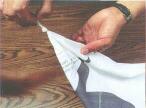
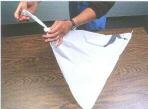
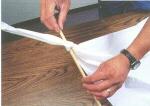
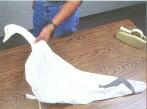
|
level of harvest slightly exceeds the
annual harvest of 1.41 million birds
that is required to reduce the Central and Mississippi Flyway light
goose population by 50 percent by
2005. Any harvest in excess of 1.4
million birds in a given year
reduces the amount of time
required to reach population reduction goals."
Goose hunters who weren't
satisfied with the limited Canada
goose season may find light goose
hunting a gratifying challenge and
may want to extend their waterfowl season. And in so doing, the
Arctic tundra will benefit greatly
from the effort.
|
Snow goose
resources
Hudson Bay
Snow Goose Research Project:
research.amnh.org/~rfr/hbp/main.html
Canadian Wildlife Service
Snow Goose Page:
www.mb.ec.gc.ca/nature/migratorybirds/dc00s04.en.html
USFWS Snow Goose Page:
http://migratorybirds.fws.gov/issues/snowgse/tblcont.html
The Virtual Goose
Reference Library:
www.goose.org
|
Below: Two freshly-made snow goose impersonators lounge in a cornfield.
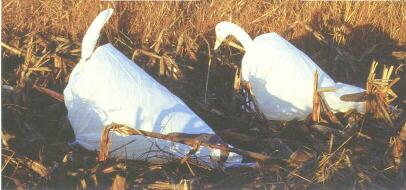
|

